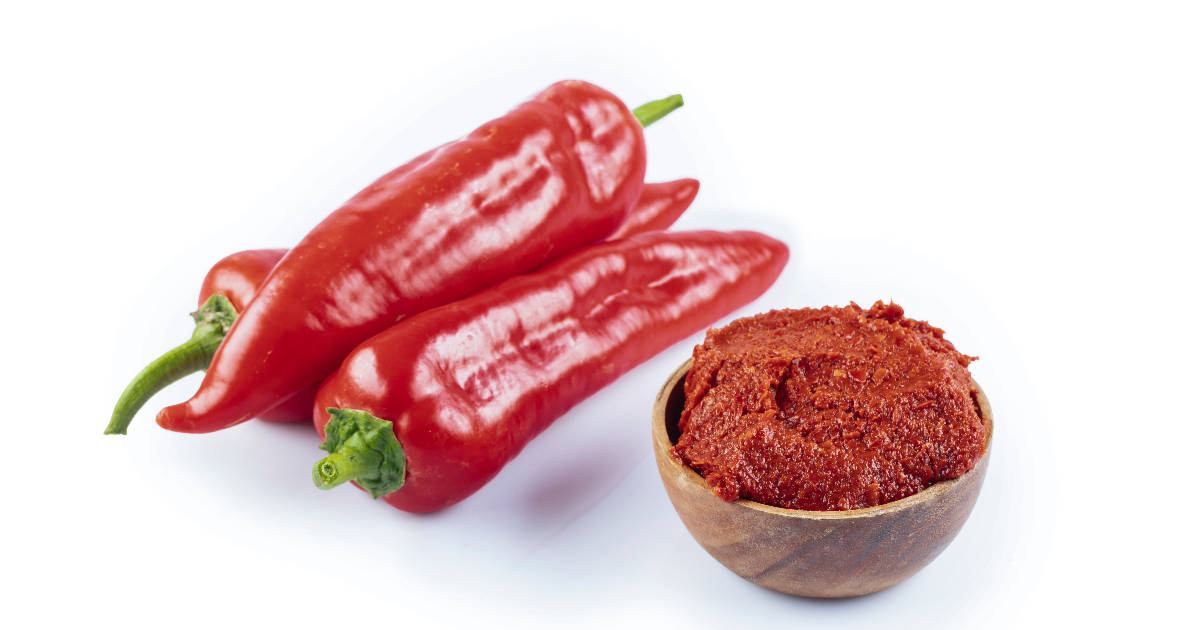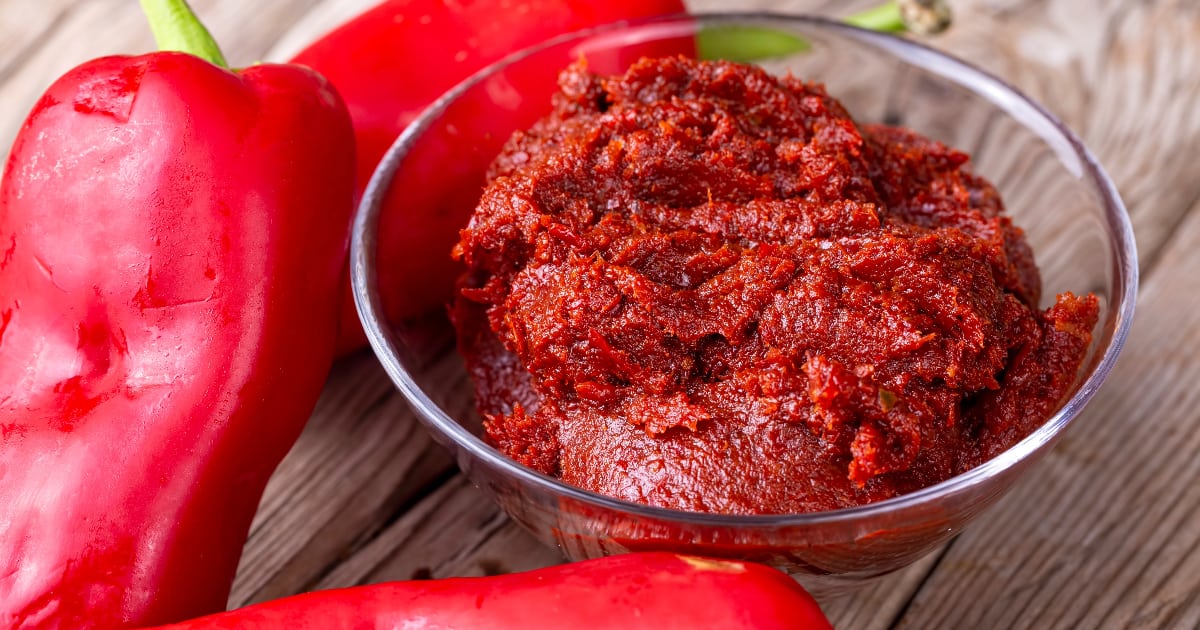Harissa and gochujang are two of the most popular spicy pastes used around the world. Both pack some serious heat and bold, complex flavors. But they actually have very different origins, ingredients, and uses.

Understanding the key differences between harissa and gochujang can help you decide when to use each in your cooking.
Harissa Originates From North Africa
Harissa paste originated in the North African country of Tunisia. It rose to prominence during the 16th century but has likely been around for much longer.
Traditional harissa gets its heat from chili peppers like serrano and Aleppo. It also contains spices like cumin, coriander, caraway and garlic. Harissa paste usually uses olive oil as its base and may contain lemon juice or vinegar for some tang.
Overall, harissa boasts a smoky, earthy flavor with moderate spice and citrusy brightness. It can taste slightly sweet thanks to the caramelized peppers. Harissa paste has a smooth, spreadable texture.
In North African cuisine, harissa steps in to add complex flavor and gentle heat to tagines, soups, couscous dishes, and more. It's also used as a condiment and dip.
Gochujang's Korean Origins

Gochujang hails from Korea and has been around for centuries. It evolved as a way to preserve chili peppers during Korea's cold winters.
This fiery paste contains sticky rice, fermented soybeans, chili powder, and salt. The fermentation gives gochujang its unique funky, umami taste.
Compared to harissa, gochujang has a stickier, denser texture thanks to the rice. The taste is very savory with a sweet yet spicy kick.
In Korean cuisine, gochujang stars in everything from bibimbap to bulgogi to stews. It also makes a mean dipping sauce.
Flavor Profiles Are Different
While both pastes provide spice, harissa, and gochujang have very distinct flavor profiles.
Harissa leans earthier and smokier, with noticeable cumin and caraway. Its citrus brightness balances the heat.
Gochujang is much funkier and umami-rich from the fermented soybeans. It tastes sweeter yet also saltier compared to harissa.
So if you're looking for a tangy, moderately spicy paste, harissa is your pick. But for a condiment with serious savoriness and sticky sweet heat, gochujang has you covered.
Harissa's Texture Is Smoother
There's a textural difference between the two pastes as well.
Harissa has a smooth, spreadable consistency thanks to its olive oil base. It can be drizzled, used as a marinade, or served as a dip.
Gochujang is much denser and stickier due to the rice used to make it. It clings to food better than harissa when used as a marinade or sauce.
So if you need something oily and pourable, harissa is the better choice. But gochujang's thickness makes it excel when you want the flavor to stick.
Gochujang Takes Much Longer to Make
Here's an interesting difference: gochujang requires a lengthy fermentation process while harissa can be made quickly.
To develop its signature funky umami flavor, gochujang is fermented for months in large clay pots outdoors.
Comparatively, harissa can be whipped up in minutes by blending its ingredients. Some recipes may include brief marinating, but this chili paste doesn't require long aging.
So when you're whipping up some harissa, you'll be enjoying it in no time. But true gochujang needs patience as its flavors slowly develop.
Harissa Works in More Cuisines
While both pastes are ethnically linked, harissa tends to work better than gochujang in a wide variety of world cuisines.
Harissa’s moderate heat level and citrusy spice notes adapt well to Middle Eastern, Mediterranean, Indian, and even American flavors.
Comparatively, gochujang’s very specific umami taste reflects its Korean origins. The sweetness and sticky texture also feel uniquely Korean.
So for a global flavor boost, harissa can spice up more dishes. But gochujang excels at adding that special Korean je ne sais quoi.
Harissa Is Easier to Find
Unless you live near an Asian market, harissa will likely be much easier to find than gochujang in local grocery stores.
Over the past decade, harissa has gone mainstream in the US and UK. Look for it in the international aisle or condiment section.
Meanwhile, gochujang remains less common outside of Asian grocers. But its popularity is rising thanks to Korean cuisine’s growing fame.
So when a recipe calls for a chili paste, harissa will probably be easier to source. But gochujang is worth seeking out for authentic Korean dishes.
Both Pastes Pack Amazing Flavor
While harissa and gochujang differ greatly, they share the ability to bring incredible flavor to your cooking.
Harissa’s gentle smoky heat enlivens everything from salad dressings to tagines.
And gochujang’s fermented savoriness works magic in Korean classics like bibimbap, while also adding a pop of umami to dips and marinades.
No matter which chili paste you choose, you can't go wrong when it comes to flavor. Let your taste preferences and recipe guide you to harissa or gochujang for a taste you'll love.
FAQ
What's the difference between red and green harissa?
The main difference is the type of pepper used. Red harissa gets its color and mild heat from dried red peppers. Green harissa uses fresh green chilies like serrano, resulting in a brighter, more herbaceous flavor and spicier heat. Some chefs mix red and green chilies for a balance.
What does harissa taste like?
Harissa boasts a rich, complex flavor thanks to its blend of spices, chilies, and garlic. It tastes smoky and earthy, along with a bright citrus note and moderate heat. The caramelized red peppers bring subtle sweetness and richness. Overall, harissa adds incredible warm, aromatic spice to dishes.
Can I substitute sambal oelek for gochujang?
Sambal oelek has a similar consistency to gochujang and provides spicy heat. However, it lacks gochujang's sweetness and umami funk from fermented soybeans. For best results, combine sambal oelek with miso paste and a bit of sugar to mimic gochujang's savory-sweet taste. Adjust amounts based on the recipe.
What foods is harissa traditionally served with?
In North African cuisine, harissa often accompanies couscous, grains, and tagine dishes. It's also used to flavor vegetable dips, salad dressings, marinated olives, and soup broths. Beyond entrees, harissa shines when served with pita bread, hard-boiled eggs, falafel, and Tunisian fricasse sandwiches.
What ingredient gives gochujang its red color?
The vibrant red hue of gochujang comes from Korean chili powder, also known as gochugaru. This coarse powder is made by drying and grinding Korean red chili peppers. Ground gochugaru gives gochujang its quintessential red color, slight sweetness, and moderate spicy heat.
Conclusion
Harissa and gochujang may seem interchangeable if you just want to add some heat. But once you understand their unique flavor profiles, it's clear they can't be swapped in recipes. Harissa shines in North African and Mediterranean dishes thanks to its complex yet moderate spice. Gochujang is perfect for authentic Korean cuisine because of its sweet funky heat and sticky texture.
Consider the dish's desired taste and texture. Let harissa and gochujang each shine in the cuisines they are meant for. But most importantly, enjoy the amazing flavors both of these fiery pastes bring to your cooking!

